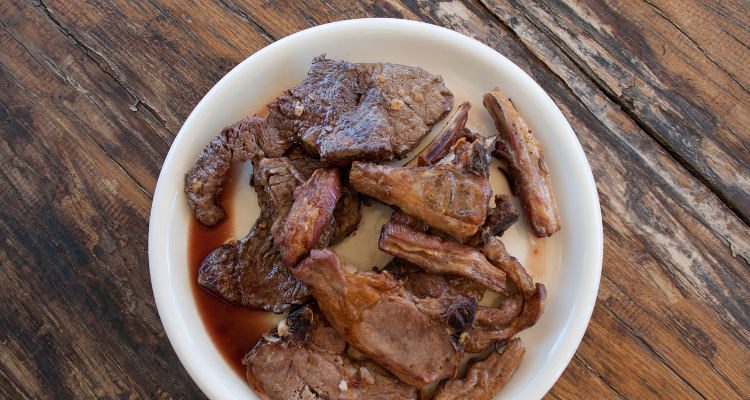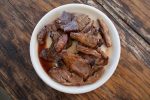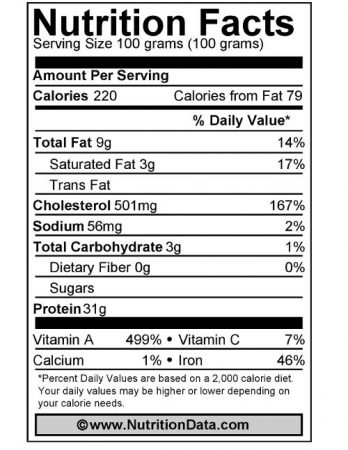
Lamb is the meat of the sheep that is less than a year old. Its meat is less fatty than its older counterparts, mutton and hogget. Lamb is more popular in the United States than mutton because of its tender texture and mild flavor. Common lamb cuts in the U.S. are the leg, rack, roast, ribs, and loin chops. Aside from its delicious taste and flavor, a lamb’s nutrition value is rich. We will discuss lamb calories, nutrition facts, and all the health benefits it has to offer.
Lamb’s Nutrition Facts
Lamb is considered red meat. It is a richer source of iron than other protein sources such as chicken and fish. Lamb meat is mostly eaten unprocessed and is low in sodium. It is an excellent source of protein, niacin, and vitamin B12. But, is lamb high in cholesterol? Yes, lamb is high in saturated fats and cholesterol, but you shouldn’t rule it out of your diet because it is rich in other vital nutrients. Let’s take a closer look.
Essential Nutrients
A grass-fed lamb’s nutrition content is diverse and healthy. It is mainly composed of protein and other essential vitamins, minerals, and good fats. Three ounces (85 grams) of cooked lamb has only 250 calories.
One ounce of cooked lamb meat will provide you with 17% DV (Daily Value) of protein, 140% DV of vitamin A (retinol), and 357% DV of vitamin B12. It will also give you good amounts of vitamin B group nutrients—riboflavin (66% DV), niacin (17% DV), thiamin, vitamin B6, and folate.
Minerals
The value of a lamb’s nutrition content is further enhanced by essential minerals such as iron, copper, phosphorus, zinc, and selenium, among others. A serving size of one ounce of lamb contains a high amount of iron (13% DV), zinc (15% DV), phosphorus (12% DV), and copper (99% DV).
Lamb meat is also a rich source of selenium (45% DV), which is required in trace amounts by our body. Other minerals that are found in lamb meat in trace amounts are magnesium, manganese, calcium, and sodium, which in appropriate amounts, are good for many aspects of our health.
Fats
Lamb meat is rich in fats, and contains a slightly higher saturated fat content than beef and pork. However, the fat content varies according to the trimming level of the animal, its diet, age, gender, and feed. The fat content of lamb meat may range from 17 to 21%, and is mostly saturated and monounsaturated fats in equal amounts.
Now, the saturated fat quantity in lamb may ring health alarm bells inside your head, but believe it or not, lamb fat is healthy! Grass-fed lamb has an incredible amount of omega-3 fats. Its omega-3 to omega-6 ratio is quite significant, and therefore, is favorable to cardiovascular health.
Lamb tallow (fat) consists of ruminant trans fats, which over the last few years, have been touted as beneficial to heart health—unlike the trans fats found in processed food products. Conjugated linoleic acid (CLA) is the most common ruminant trans fat found in red meat like lamb, beef, and veal. It has been linked to many health benefits, including the potential to reduce inflammation and body fats, which further lowers the risk of heart disease.
About 40% of lamb tallow includes a monounsaturated fat called oleic acid. This fat is also found in extra virgin oil, for which it is lauded. Oleic acid also reduces heart disease risk.
Furthermore, lamb’s nutrition also includes a handful of bioactive nutrients and antioxidants such as creatine, taurine, and cholesterol. Creatine is essential for muscle health. It serves as a source of energy for muscles, and is useful in growth and maintenance of lean muscle mass.
Protein
A lamb’s protein content and other nutrients such as vitamin A (retinol), B group vitamins (especially B12), and minerals such as iron and copper, are extremely vital for good health. Lamb is an excellent source of protein. In fact, a lamb’s protein content is about 17% DV for 28 grams, or one serving of the meat when cooked.
The protein in lamb contains all the important amino acids that promote the body’s growth and muscle maintenance. It helps to quickly repair damaged tissue and builds up muscles, too. A serving of 100 grams of cooked lamb will provide 25 grams of protein. Eating lamb as a protein source will not only top up your recommended dietary allowance (RDA) of energy, but also replenish iron, zinc, and selenium deficiencies in the body.
High-quality protein is necessary to maintain muscle mass. This is especially so in elderly people, because insufficient protein intake may accelerate and worsen age-related muscle mass deterioration. Consequently, this increases the risk of sarcopenia, a condition associated with very low muscle mass.
Lamb protein can also improve muscle function due to the amino acid beta-alanine. It is used by the body to generate carnosine, which is vital for muscle function as it decreases muscle fatigue and enhances its performance. Thus, it is often included in the diets of athletes and bodybuilders.
Therefore, is lamb a good source of protein? Yes, it is. With rich amounts of beta-alanine amino acids, lamb meat is a wonderful source of high-quality protein. Lamb nutrition may improve muscle function, stamina, and exercise performance while maintaining muscle mass.
Is Lamb High in Cholesterol?
Lamb’s nutrition includes a fair amount of dietary cholesterol. Dietary cholesterol is an essential nutrient, and according to scientific research, it does not affect the blood cholesterol level much. The lean portions of lamb, like the tenderloin, loin chops and legs, are composed of relatively less fat and cholesterol.
Cholesterol is a waxy substance that is produced in the liver and is found in body cells. Good cholesterol such as HDL (high-density lipoprotein) is required by the body.
It helps in making bile, a digestive juice secreted by the liver to break down complex foods. It also aids digestion, hormone production, and vitamin D production. Since our body is capable of making cholesterol, foods containing higher trans and saturated fats may cause an overload of cholesterol in the body, which may lead to inflammation.
On the other hand, cholesterol-rich foods like lamb consist of arachidonic acid (AA). This fatty acid is essential in growing children, and in pregnant or nursing women. It is responsible for muscle inflammation, and therefore, is favorable to individuals who are bodybuilders or those suffering from degenerative diseases involving oxidative stress. Arachidonic acid (AA) also helps in quick recovery from injuries.
A deficiency of arachidonic acid (AA) in the body may cause scaly skin, hair loss, and infertility. Thus, it is healthy to eat lamb, even though it is high in cholesterol. As long as you have it in moderation, lamb is beneficial for overall health, since it has an impressive nutrition profile.
Is Lamb a Lean Meat?
Lamb is a red meat due to its high myoglobin content—a protein that turns red when combined with oxygen. But is lamb a lean meat? Well, inherently, lamb is not a lean meat as it is high in saturated fat and cholesterol. However, as previously mentioned, the fat content varies with the cut of meat. Lamb loin chop, arm chop, and foreshanks are some of the leaner cuts, wherein the visible fat is trimmed.
According to the United States Department of Agriculture (USDA), a serving of three ounces of meat with less than 10 grams total fat, 4.5 grams saturated fat, and 95 milligrams cholesterol is considered lean meat. While chicken and turkey without the skin are the best lean protein options, if you like lamb, then choose the leaner parts (e.g., sirloin, shoulder, shanks, top round, etc.).
The lean parts of lamb turn out to be much leaner after they are cooked. A factor to be mindful of, however, is the cooking method used. Methods such as grilling, broiling, and roasting will further reduce the fat content, whereas pan-frying will step it up.
Red meats like lamb are not always bad for health. Lamb is a good source of protein, vitamins, good fats, and essential minerals. So, take a break from poultry meat and fish, and incorporate red meat like lamb in your diet once a week. A lamb’s nutrition profile is rather impressive, and eating it as a protein source can prove to be advantageous to your health. Now that you understand which cuts of the animal can offer lean meat, enjoy it in moderation for good health.
Related:
Sources:
Prakash, S., “What’s the Difference Between Lamb and Mutton?” Kitchn, April 27, 2016; http://www.thekitchn.com/whats-the-difference-between-lamb-and-mutton-230038, last accessed March 20, 2017
Arnarson, A., “Lamb 101: Nutrition Facts and Health Effects,” Authority Nutrition; https://authoritynutrition.com/foods/lamb/, last accessed March 20, 2017
“ Lamb, grass-fed,” The World’s Healthiest Foods; http://www.whfoods.com/genpage.php?tname=foodspice&dbid=117,
Attard, M., “Is Lamb Meat Healthy?” Livestrong, April 16, 2015; http://www.livestrong.com/article/381828-is-lamb-meat-healthy/, last accessed March 20, 2017
“THE 10 SOURCES OF PROTEIN EVERY MAN NEEDS,” Men’s Health, May 17, 2016; http://www.menshealth.co.uk/food-nutrition/muscle-foods/the-worlds-best-protein-sources-313853, last accessed March 20, 2017
“Foods High in Cholesterol Could Save Your Health!” Cholesterol and Health, March 2007; http://www.cholesterol-and-health.com/Foods-High-In-Cholesterol.html, last accessed March 20, 2017
“Side effects and health benefits of arachidonic acid,” Body Nutrition; http://bodynutrition.org/arachidonic-acid/, last accessed March 20, 2017
“Is Lamb Red Meat?” Berkeley Wellness, May 19, 2015; http://www.berkeleywellness.com/healthy-eating/food/article/lamb-red-meat, last accessed March 20, 2017
“HEALTHY LEAN MEATS,” The Paleo Diet, February 17, 2011; http://thepaleodiet.com/healthy-lean-meats/, last accessed March 20, 2017














